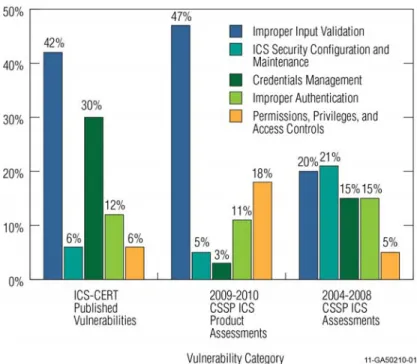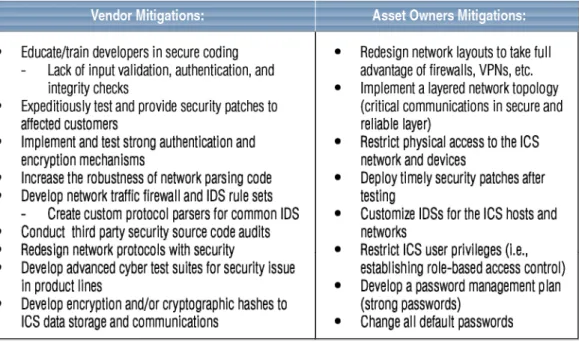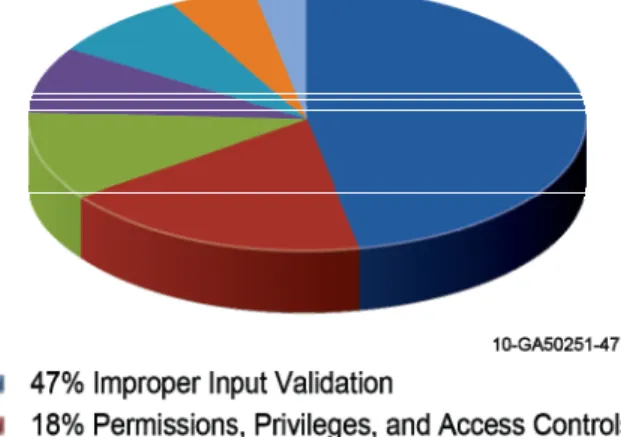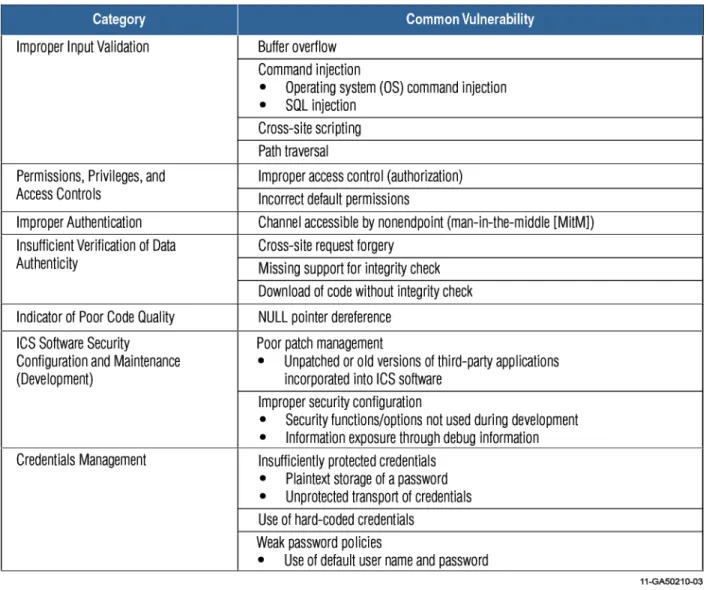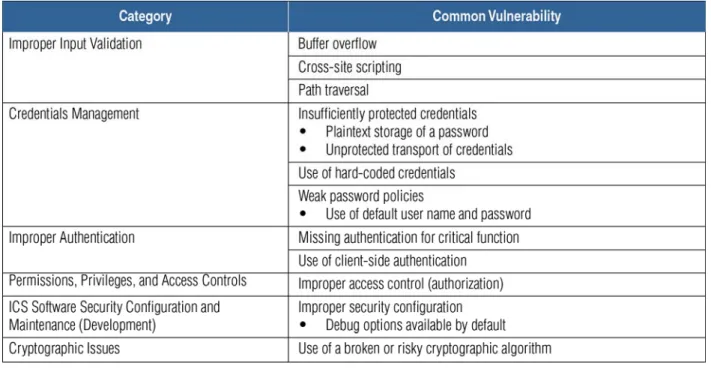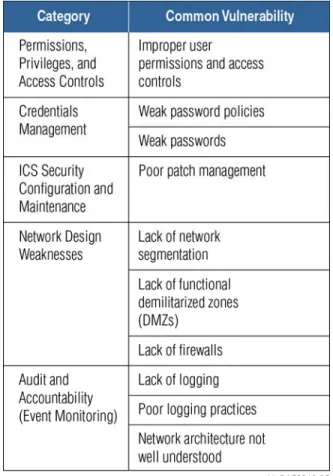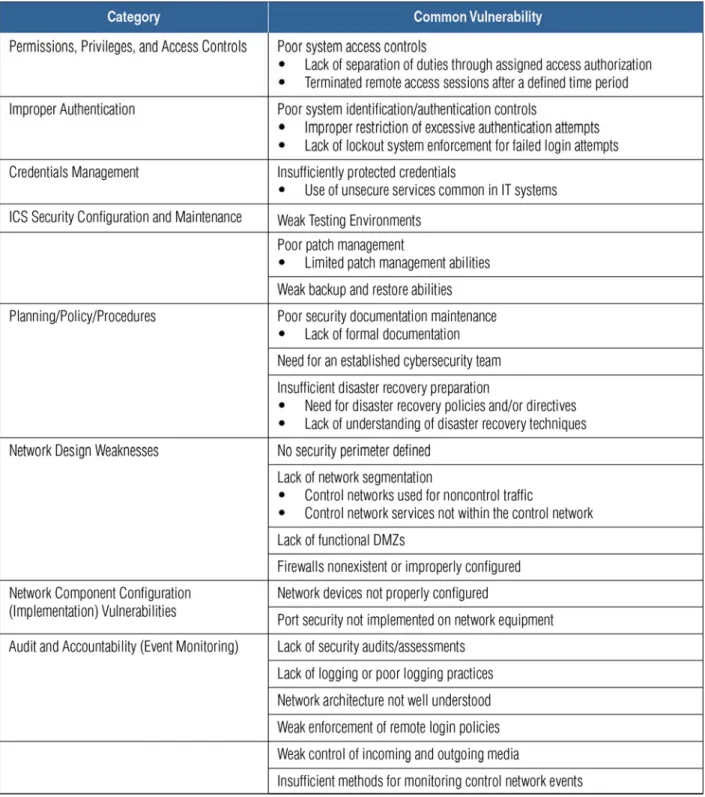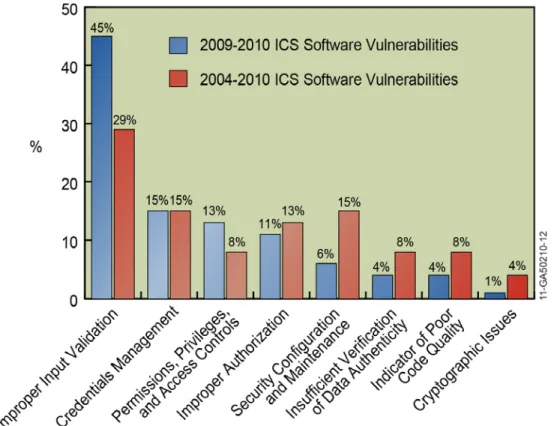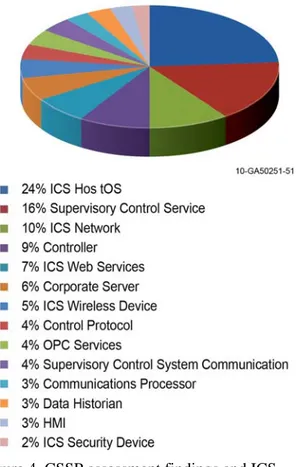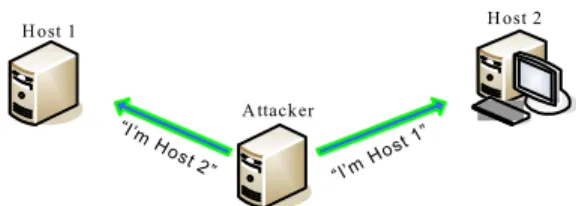Common Cybersecurity Vulnerabilities in
Industrial Control Systems
DISCLAIMER
This report was prepared as an account of work sponsored by an agency of the U.S. Government. Neither the U.S. Government nor any agency thereof, nor any employee, makes any warranty, expressed or implied, or assumes any legal liability or responsibility for any third party’s use, or the results of such use, or any
information, apparatus, product, or process disclosed in this publication, or represents that its use by such third party would not infringe privately owned rights.
iii
ACKNOWLEDGMENTS
Trent Nelson, Project Manager, Idaho National Laboratory; May Chaffin, Cyber Researcher, Idaho National Laboratory
v
EXECUTIVE SUMMARY
The U.S. Department of Homeland Security (DHS) National Cyber Security Division’s Control Systems Security Program (CSSP) performs cybersecurity vendor assessments, ICS-CERT operations, and asset owner cybersecurity evaluations with the Cyber Security Evaluation Tool (CSET) evaluations for industrial control systems (ICS) to reduce risk and improve the security of ICS and its components used in critical infrastructures throughout the United States. ICS differs from other computer systems because of legacy-inherited
cybersecurity weaknesses and the significance of the impact of potential exploitation to the U.S.
In 2009,a report titled “Common Cyber Security Vulnerabilities Observed in DHS Industrial Control Systems Assessments” compiled common vulnerabilities identified during 15 security assessments of new ICS products and production ICS installations from 2004 through 2008. Three additional ICS product assessments were performed in 2009 and 2010. This newer, 2010 version is an update to the 2009 version and has been developed to proactively create greater awareness within the ICS community. Correlated and compiled in this report are vulnerabilities from general knowledge gained from DHS CSSP assessments and Industrial Control Systems Cyber Emergency Response Team (ICS-CERT) activities describing the most common types of cybersecurity vulnerabilities as they relate to ICS. This information is derived from DHS CSSP experiences of the following types:
Assessments of ICS products
Published products derived from ICS-CERT operations, including ICS-CERT incident response
Self-assessments of asset-owner facilities using the Cyber Security Evaluation Tool (CSET).
Cybersecurity vulnerability and mitigation information from authoritative sources is referenced to guide those responsible for securing ICS used in critical infrastructures throughout the United States.
The highest percentage of vulnerabilities identified in ICS product
assessments continues to be improper input validation by ICS code. Poor access controls—credentials management and security configuration—were the second most common security weakness identified in new ICS software in 2009–2010. Authentication weaknesses follow in third place. However, vulnerabilities reported from the previous CSSP ICS product assessments include more patch management problems than the more recent findings.
ICS-CERT alerts match 2009–2010 CSSP assessment findings, with most of the published ICS vulnerabilities due to improper input validation, but have a much higher percentage of password weaknesses. See Figure EX-1.
vi
Figure EX-1. Comparison of ICS software security weaknesses. Production system assessments were performed using the CSET policy-based self-assessment tool in 2009–2010. Individual site vulnerabilities were not recorded from these assessments, but summary reports indicate that the lack of formal documentation is the most common gap identified. ICS-CERT incident response participants have observed an overall lack of defense-in-depth at ICS installations. Prior CSSP site assessments found that the most common configuration problem was credentials management (i.e., weak passwords and insufficiently protected credentials), followed by weak or non-existent firewall rules and network design weaknesses. Table EX-1 ranks the security problem areas identified at production ICS sites.
Table EX-1. Most common weaknesses identified on installed ICS.
The identified common vulnerabilities from the CSSP assessments are shared here to increase security awareness and mitigation. ICS vendors and owners can learn and apply many common computer-security concepts and practices to secure and protect their systems. Security should be designed and implemented by qualified security and ICS experts who can verify that the solutions are effective and can make sure that the solutions do not impair the system’s
vii reliability and timing requirements. Given the nature of the vulnerabilities found
in ICS, asset owners cannot always directly fix them. Thus, as asset owners wait for vendor patches and fixes, the design and implementation of defense-in-deptha security strategies that aid in protecting the ICS from attack is part of an
effective, proactive security program. Such a program is a necessity because attack strategies are constantly evolving to compensate for increasing defense mechanisms.
To encourage a proactive program, vendors should offer or support security products and features that can be used as layers of defense to help protect ICS installations. Owners should add the additional network perimeter layers of defense and actively update and monitor the system. Increasing the hurdles required to attack a system decreases the chance that attackers will be able to subvert all hurdles and increases the chance that the attackers will give up before accomplishing their goals. Designing security into the system and using secure coding and best practices regarding security can also minimize damage from attacks by insiders, social engineers, or anyone else with access behind the ICS network perimeter.
ICS product vendors are responsible to deliver systems that are able to survive attack without compromising critical functionality. ICS owners must ensure that the physical systems they operate do not put lives, the economy, or the environment at risk by the owners’ failing to perform due diligence in procuring, configuring, securing, and protecting the ICS for critical
infrastructure. In support of this goal, Table EX-2 presents recommendations for establishing the best possible defense against evolving attack strategies.
Table EX-2. Vendor Mitigations.
a. http://www.us-cert.gov/control_systems/practices/documents/Defense_in_Depth_Oct09.pdf, Recommended Practice: Improving Industrial Control Systems Cybersecurity with Defense-In-Depth Strategies
ix
CONTENTS
ACKNOWLEDGMENTS ... iii
EXECUTIVE SUMMARY ... v
1. INTRODUCTION ... 1
2. VULNERABILITY INFORMATION SOURCES ... 2
2.1 CSSP ICS Security Assessments ... 2
2.1.1 Common CSSP ICS Cybersecurity Assessment Vulnerabilities ... 3
2.2 ICS-CERT Products ... 4
2.2.1 Common ICS-CERT Vulnerability Announcements ... 5
2.3 CSET Self-Assessment Tool ... 6
2.4 Compilation of ICS Vulnerability Information ... 7
3. UNDERSTANDING COMMON ICS VULNERABILITIES ... 12
3.1 Common ICS Software/ Product Security Weaknesses ... 12
3.1.1 Improper Input Validation ... 12
3.1.2 Poor Code Quality ... 17
3.1.3 Permissions, Privileges, and Access Controls ... 18
3.1.4 Improper Authentication ... 19
3.1.5 Insufficient Verification of Data Authenticity ... 22
3.1.6 Cryptographic Issues ... 24
3.1.7 Credentials Management ... 25
3.1.8 ICS Software Security Configuration and Maintenance (Development) ... 26
3.1.9 Summary of Common ICS Software Vulnerabilities ... 26
3.2 Common ICS Configuration Weaknesses ... 28
3.2.1 Permissions, Privileges, and Access Controls ... 28
3.2.2 Improper Authentication ... 30
3.2.3 Credentials Management ... 32
3.2.4 ICS Security Configuration and Maintenance ... 35
3.2.5 Planning/Policy/Procedures ... 37
3.2.6 Audit and Accountability ... 40
3.2.7 Summary of Common ICS Configuration Vulnerabilities ... 41
3.3 Common ICS Network Security Weaknesses ... 42
3.3.1 Common ICS Network Design Weaknesses ... 42
3.3.2 Weak Firewall Rules ... 45
3.3.3 ICS Network Component Configuration (Implementation) Vulnerabilities ... 46
3.3.4 Audit and Accountability ... 47
3.3.5 Summary of Common ICS Network Vulnerabilities ... 48
4. ICS SECURITY RECOMMENDATIONS ... 50
4.1 Recommendations for Vendors ... 50
4.1.1 Create a Security Culture ... 51
4.1.2 Enhance ICS Test Suites ... 52
4.1.3 Create and Test Patches ... 53
x
4.1.5 Increase Robustness of Network Parsing Code ... 54
4.1.6 Create Custom Protocol Parsers for Common IDSs ... 55
4.1.7 Document Necessary Services and Communication Channels ... 55
4.1.8 Redesign ICS to Use the Least Communication Channels Possible ... 55
4.1.9 Implement and Test Strong Authentication and Encryption Mechanisms ... 55
4.1.10 Improve Security through External Software Security Assessments ... 56
4.2 Recommendations for ICS Owners and Operators ... 56
4.2.1 Restrict ICS User Privileges to only those Required ... 58
4.2.2 Change All Default Passwords and Require Strong Passwords ... 58
4.2.3 Test and Apply Patches ... 58
4.2.4 Protect Critical Functions with Network Security Zones and Layers ... 59
4.2.5 Customize IDS Rules for the ICS and Closely Monitor Logs ... 60
4.2.6 Force Security through External Software Security Assessments ... 61
5. REFERENCES ... 62
Appendix A—Terms and Definitions ... 63
Appendix B—CSET Self Assessment Activities ... 69
Appendix C—Acronyms ... 73
FIGURES
Figure EX-1. Comparison of ICS software security weaknesses. ... viFigure 1. Categories of vulnerabilities identified in 2009–2010 CSSP product assessments. ... 3
Figure 2. Percentage of 20092010 ICS-CERT vulnerability disclosures. ... 5
Figure 3. Percentage of 20092010 CSSP assessment findings and ICS-CERT vulnerability disclosures. ... 9
Figure 4. CSSP assessment findings and ICS-CERT vulnerability disclosures per ICS component type. ... 10
Figure 5. CSSP assessment findings and ICS-CERT vulnerability disclosures by ISA99 reference model levels. ... 10
Figure 6. Generic man-in-the-middle attack. ... 22
Figure 7. Recommended defense-in-depth ICS architecture. ... 44
TABLES
Table EX-1. Most common weaknesses identified on installed ICS. ... viTable EX-2. Vendor Mitigations. ... vii
Table 1. Common security weaknesses identified in 2009–2010 CSSP product assessments. ... 4
Table 2. Common security weaknesses reported to ICS-CERT in 2009 and 2010. ... 5
Table 3. Major incident response observations. ... 6
xi
Table 5. Reference model for ISA99 standards. ... 11
Table 6. Common ICS software vulnerabilities identified through CSSP and ICS-CERT activities. ... 27
Table 7. Summary of common ICS configuration findings. ... 41
1
Common Cybersecurity Vulnerabilities Identified in
DHS Industrial Control Systems Products
1. INTRODUCTION
The U.S. Department of Homeland Security (DHS) National Cyber Security Division’s Control Systems Security Program (CSSP) performs cybersecurity assessments of industrial control systems (ICS) to reduce risk and improve the security of ICS and their components used in critical infrastructures throughout the United States. DHS also sponsors the Industrial Control Systems Cyber Emergency Response Team (ICS-CERT) to provide a control system security focus in collaboration with US-CERT (United States Computer Emergency Readiness Team). This report has been developed to share the knowledge and information gained by both of these programs.
This report correlates and compiles vulnerabilities from general knowledge gained from DHS CSSP assessments and ICS-CERT activities and reports the most common types of cybersecurity vulnerabilities as they relate to ICS. DHS CSSP derives the information based on the following activities:
Cybersecurity assessments of ICS products Published products derived from operation of
ICS-CERT
Self-assessments of asset owner facility using the Cyber Security Evaluation Tool (CSET). The term “ICS,” as used throughout this report, includes Supervisory Control and Data Acquisition (SCADA) systems, Process Control Systems, Distributed Control Systems, and other control systems specific to any of the critical infrastructure industry sectors. Although
differences in these systems exist, their similarities enable a common framework for discussing and
defining security controls. Standard cybersecurity concepts apply to all computer hardware and software, and common issues in ICS can be discussed in general terms.
Common ICS vulnerabilities and associated recommendations are discussed in this report. Insight is gained into the current state of ICS security through high-level analysis of the problem areas by information gathered from CSSP ICS security assessments and ICS-CERT alerts, advisories, and incident response.
This report is organized in three sections. First, the different sources of ICS vulnerability information are summarized. Then the common ICS vulnerabilities are presented according to categories that describe a general problem observed in multiple ICS security assessments. These three general categories are grouped by: 1. Vulnerabilities inherent in the ICS product 2. Vulnerabilities caused during the installation,
configuration, and maintenance of the ICS 3. The lack of adequate protection because of
poor network design or configuration. Nonattributable ICS vulnerabilities are listed with the common vulnerability descriptions to aid in understanding the issues. General
recommendations based on empirical knowledge gained through performing ICS security
assessments are then grouped by software development recommendations for ICS vendors, ICS network configuration, and maintenance recommendations for ICS owners.
2
2. VULNERABILITY
INFORMATION
SOURCES
This report is an update of a previous report first published in 2009.1 The previous document compiled common vulnerabilities identified during cybersecurity assessments of new ICS products and production ICS installations. This report adds the information gained from subsequent ICS cybersecurity assessments with new content from ICS-CERT products, field-knowledge gained by ICS-CERT incident response, and onsite
assessments assisting ICS owners in using the CSET self-assessment tool.
These different sources of ICS vulnerability information provide a more complete picture of ICS security: (1) CSSP has performed
cybersecurity assessments of ICS software and production installations since 2004, (2) ICS-CERT started publishing vulnerability information and assisting in incident response in 2010, and (3) CSSP has assisted in Control System Cyber Security Self-Assessment Tool (CS2SAT) and CSET policy self-assessments since 2006, Each of these sources is covered in the subsequent sections followed by a discussion of the compiled source information and a comparison against information from past years.
2.1 CSSP ICS Security
Assessments
The DHS National Cyber Security Division established the CSSP to help industry and government improve the security of the ICS used in critical infrastructures throughout the United States. A key part of the CSSP mission is the assessment of ICS to identify vulnerabilities that could put critical infrastructures at risk to cyber attack. Once these vulnerabilities are identified, mitigation strategies are developed to enhance ICS security.
CSSP has established a collaborative effort among vendors, owners/operators, industry partners, and other national laboratories to provide an assessment environment where ICS can be evaluated for security vulnerabilities. This controlled environment allows realistic
assessments of systems and components without
the adverse consequences resulting from potential system failures.
Assessments are performed at Control Systems Analysis Center, located at the Idaho National Laboratory, to evaluate vendors’ ICS software. Assessments also are performed at ICS sites in order to assess security issues due to the interdependencies and network design of operational ICS installations. Operational ICS assessments use nonintrusive methods, such as reviewing the production system network diagrams and firewall rules, and performing a hands-on assessment of a duplicate nonproduction installation of the system.
The primary goal of the CSSP cybersecurity assessments is to improve the security of the critical infrastructure by delivering to each industry partner a report of all security problems found during the assessment along with associated recommendations for improving the security of their product or infrastructure (as appropriate). The CSSP has performed assessments on a large variety of systems, and for each assessment, CSSP tailors the assessment plan and methodology to provide the most value to the customer owning the system. System configurations also vary
considerably depending on ICS functionality, negotiated objectives, and whether the assessment was conducted in the laboratory or onsite. In all cases, the architecture and boundaries for the system under test are carefully determined. Assessment targets are developed individually for each assessment based on the system configuration and assessment focus in order to address the concerns of the partners. Although a common approach is used for all assessments, the details of each assessment vary; the fact that a vulnerability was not listed on a particular system report does not imply that it did not exist on that system. CSSP vulnerability identification activities focus on enabling the identification and remediation of the highest risk ICS cybersecurity vulnerabilities rather than the collection of data for statistical purposes. One should keep this in mind when interpreting common vulnerability data.
3 Laboratory assessments are designed to
evaluate vendor-specific products and services, such as custom protocols, field equipment, applications, and services. Ideally, the systems are assessed in multiple phases: (1) a baseline system assessment that identifies vulnerabilities in the vendor’s default configuration and (2) an
evaluation of the system following implementation of mitigation strategies based on baseline
assessment results. In some cases, more than two assessments have been performed on different versions of an ICS. Assessment projects typically leverage a full-disclosure approach with the vendor and asset-owner partners. The CSSP focus is on the ICS and its perimeter. By collecting background architecture, policy, and configuration data from a project partner, the team can perform a more thorough assessment of the system.
Penetration testing is a security validation process performed by many commercial entities. CSSP does not simulate a blind attack or penetration of the system, but instead works with the project partner to gain the best understanding of security issues obtainable within the time constraints, and provide insight to help mitigate the vulnerabilities found.
2.1.1
Common CSSP ICS
Cybersecurity Assessment
Vulnerabilities
The previous report1 presented results from 15 ICS cybersecurity assessments performed by the CSSP from 2004 through 2008. Three
additional ICS product assessments are included in this report. Figure 1 shows the categories of vulnerabilities that were identified in the three product assessments performed in 2009 and 2010. Table 1 summarizes these vulnerabilities.
The highest percentage of vulnerabilities identified during ICS product assessments
continue to be due to improper input validation by ICS code. Poor access controls are the second most common security weakness identified in ICS software in 20092010. Authentication
weaknesses follow in third place.
Vulnerabilities reported from the previous CSSP ICS product assessments include more patch management and password problems than the more recent findings. This may be more indicative of the types of systems that were assessed than a change in ICS vulnerability.
Figure 1. Categories of vulnerabilities identified in 2009–2010 CSSP product assessments.
4
Table 1. Common security weaknesses identified in 2009–2010 CSSP product assessments.
2.2 ICS-CERT
Products
ICS-CERTb provides a control system security focus in collaboration with US-CERT to:
Respond to and analyze control systems-related incidents
Conduct vulnerability and malware analysis Provide onsite support for incident response
and forensic analysis
Provide situational awareness in the form of actionable intelligence
b. http://www.us-cert.gov/control_systems/ics-cert/
Coordinate the responsible disclosure of vulnerabilities/mitigations
Share and coordinate vulnerability information and threat analysis through information products and alerts.
ICS-CERT serves as a key component of the Strategy for Securing Control Systems, which outlines a long-term, common vision where effective risk management of control systems security can be realized through successful coordination efforts.
This report uses information gathered from ICS-CERT alerts and advisories published between October 2009 and December 2010. In addition, general knowledge gained from incident
5 response and forensic analysis is included in this
report as well.
2.2.1 Common
ICS-CERT
Vulnerability Announcements
ICS-CERT alerts and advisories contain information about suspicious cyber activity, incidents, and vulnerabilities affecting critical infrastructure control systems. An ICS-CERT alert discloses information about an ICS-relatedvulnerability that was reported to them. An ICS-CERT Advisory is intended to provide awareness or solicit feedback from critical infrastructure owners and operators concerning ongoing cyber events or activity with the potential to impact critical infrastructure computing networks.
Figure 2 shows the categories of
vulnerabilities that were reported to ICS-CERT in 2009 and 2010. The highest percentage of reported ICS vulnerabilities are buffer overflow
vulnerabilities. Credentials management and authentication weaknesses make up the bulk of the remaining published ICS vulnerabilities. Table 2 summarizes the vulnerabilities that were reported to ICS-CERT in 2009 and 2010.
Figure 2. Percentage of 20092010 ICS-CERT vulnerability disclosures.
6
2.2.1.1 Common Incident Response
Observations
ICS-CERT incident response activities are performed at the request of owners and operators to assist in the review of network architecture, security practices, and system configurations. ICS-CERT incident response participants have
observed an overall lack of defense-in-depth at ICS installations. Table 3 shows the biggest security weaknesses observed at ICS installations.
Some of the sites visited had not segmented the control network and had multiple connections from the control network to the corporate network and to remote sites as one flat network. Many peer and remote site connections were routed over leased networks. Many sites did not limit access between their disparate locations. This means that once any host on the company’s network is compromised, there are few access controls preventing malicious intent.
Table 3. Major incident response observations.
Firewalls should be used to filter traffic between security zones. Some sites had
implemented network segmentation using VLANs (virtual local area networks) without firewalls. Firewalls should be used to block unauthorized traffic in the case that the VLAN access controls are subverted.
User permissions and access controls should also be limited to those necessary to perform their roles. Some sites trusted all users equally or allowed more access than necessary.
After an incident has occurred, systems logs can be used to help determine the cause of the problem or how the system was attacked. Many sites either did not store system logs or overwrote them within a short period of time. Though not frontline cybersecurity barrier against a threat, event monitory and logging is critical to the capture of forensic data, which ultimately could lead to additional cybersecurity resilience.
2.3 CSET
Self-Assessment
Tool
The CSETc combines the functionality of two earlier tools, the CS2SAT, and the Cyber Security Vulnerability Assessment Tool. The Cyber Security Vulnerability Assessment Tool
functionality is called Enterprise Evaluation or EE in CSET.
CSET is a self-assessment software standards application for performing cybersecurity reviews of industrial control and enterprise network systems. The tool may be used by any
organization to assess the cybersecurity posture of ICS that manage a physical process or enterprise network. The tool also provides information that assists users in resolving identified weaknesses in their networks and improving their overall security posture.
CSET provides users in all infrastructure sectors with a systematic and repeatable approach for performing assessments against multiple standards, recommended security practices, and industry requirements. CSET provides a flexible question and answer format for performing
7 assessments. Users may apply the tool to
site-specific configurations, based on user created diagrams and selection of specific standards for each assessment.
CSET is a desktop software tool that guides users through a step-by-step question and answer process to collect facility-specific control and enterprise network information. The questions address topics such as hardware, software,
administrative policies, and user obligations. After the user responds to the questions, the tool
compares the information provided to relevant security standards and regulations, assesses overall compliance, and provides appropriate
recommendations for improving the system’s cybersecurity posture. The tool pulls its recommendations from a database of the best available cybersecurity practices, which have been adapted specifically for application to control system and enterprise networks and components. Where appropriate, recommendations are linked to a set of prioritized actions that can be applied to remediate specific security vulnerabilities.
CSET requirements were derived from widely accepted standards such as:
DHS Catalog of Control Systems Security: Recommendations for Standards Development Revisions 4 and 6
NIST SP 800-53: National Institute of Standards and Technology (NIST), Special Publication (SP) 800-53, Recommended Security Controls for Federal Information Systems, Revisions 0, 1, 2, and 3 Final Public Draft, June 2009
NIST SP 800-82: National Institute of Standards and Technology, SP 800-82, Guide to Industrial Control Systems (ICS) Security, Final Public Draft, September 2008
ISO/IEC 15408 (The Common Criteria): International Organization of Standards/ International Electrotechnical Commission, Version 3.1, September 2007
DoDI 8500.2: US Department of Defense (DoD) Instruction Number 8500.2, “Information Assurance (IA) Implementation,” February 6, 2003
NERC CIP-002 through CIP-009: North American Electric Reliability Corporation (NERC) Critical Infrastructure Protection (CIP) (http://www.nerc.com/), Effective June 1, 2006.
2.3.1.1 Common CSET Findings
The CSSP assisted in 50 CSET self-assessments in 2010 at owners and operations facilities within the 18 critical sectors, and in multiple CS2SAT self-assessments between 2006 and 2009. The CSSP provides the following benefits during the CSET evaluations: Cyber Security Awareness Briefing CSET training and demonstration
“Over-the Shoulder” guidance to asset owners in using CSET
Collective knowledge of common issues and good practices to identify vulnerabilities and mitigate risk
Review assessment findings and provide mitigation techniques.
Table 4 summarizes the issues commonly identified as cybersecurity gap by ICS asset owners during onsite CSET assessments.
2.4 Compilation of ICS
Vulnerability Information
DHS ICS risk reduction activities have gathered vulnerability information from many different types of ICS components, used by the multiple types of ICS. Information from different assessment approaches and ICS types provides a more complete picture of the security risks to ICS. Common types of vulnerabilities identified through CSSP assessments, ICS-CERT activities, and CSET self-assessments have been named and classified using consistent criteria, such as the Common Weakness Enumeration (CWE)d where possible, to enable correlation of vulnerability data. However, one should be careful about drawing conclusions from the data presented in this report.
8
9 All systems were not assessed for the same set
of security weaknesses. The lack of vulnerabilities identified by a particular approach does not indicate that systems were found to not be vulnerable to that weakness.
Many of the security weaknesses indentified in installed ICS are not quantifiable because DHS does not keep detailed vulnerability information identified during CSET and incident response activities. This section compiles all common vulnerabilities identified by DHS activities and categorizes quantifiable vulnerabilities by categories and affected component types.
CSSP ICS product assessment reports and ICS-CERT alerts and advisories mainly contain vulnerabilities inherent in ICS software. ICS site assessments and incident response look at the security of the ICS environment.
At a high level, common vulnerabilities are categorized differently based on how the problem is being viewed. Figure 3 groups common
ICS vulnerabilities according to eight general security categories that sum up the main weaknesses identified in ICS products by CSSP assessments and ICS-CERT vulnerability disclosures. Figure 3 compares the current
cybersecurity issues based on assessment activities within the past eighteen months to the
accumulative cybersecurity issues from 2004 to present.
Current vulnerabilities (2009-2010) identified in ICS product assessments continue to be
improper input validation by ICS code. Through bad coding practices and improper input
validation, access can be granted to an attacker allowing them to have unintended functionality or privilege escalation on the systems. Examples of improper input validation identified are within buffer overflows, boundary checking, and code injection. Other high-level security issues are poor access controls—credentials management and security configuration.
10
Based on assessment activities and the industry culture change towards more secured ICS, the vendor and asset owners community has increased in the patch management process and has reduced known vulnerabilities by patching ICS.
These categories summarize the main causes of vulnerabilities that put ICS software at risk to cyber attack.
ICSs are made up of process equipment, process control hardware, network devices, and computers. Vulnerabilities in network devices and protocols, or the operating systems, ICS software, and other software running on the ICS computers could allow an attacker to gather information about, disrupt, or manipulate ICS operations. The percentage of CSSP assessment vulnerabilities that were found in common ICS component types are shown in Figure 4.
Figure 4. CSSP assessment findings and ICS-CERT vulnerability disclosures per ICS component type.
The International Standards Association (ISA) reference model creates a framework for
referencing general Industrial Automation and Control Systems (IACS) network levels.2 Although all CSSP assessment system networks were not designed consistently, this framework allows the findings to be consistently categorized by logical network layers. Each level represents a class of functionality. Table 5 lists the ISA SP99 reference model levels and associated IACS and SCADA functions.
The majority of functionality evaluated in CSSP assessments was at the supervisory control level. None of the assessments used for this report listed findings at the process level. Figure 5 illustrates the percentage of CSSP assessment findings and ICS-CERT vulnerability disclosures identified in each of the ISA reference model levels.
Figure 5. CSSP assessment findings and ICS-CERT vulnerability disclosures by ISA99 reference model levels.
11 Table 5. Reference model for ISA99 standards.
12
3. UNDERSTANDING
COMMON ICS VULNERABILITIES
A major difference in securing ICS and a typical computer system is in the ICS components that do not use standard information technology (IT) hardware or software. Custom ICS hardware and software have not been scrutinized like common computer products, and refresh rates are typically much lower.
Another difference is the prioritization of security objectives. While adding security measures to ICS components, it is important to keep in mind functional requirements. Unlike typical IT systems, ICS security objectives are typically prioritized as:
1. Availability 2. Integrity 3. Confidentiality.
Violating operational requirements while implementing security features in ICS could cause more damage than a cyber attack.
CSSP ICS security assessments have identified the vulnerabilities described in this section in a majority of the systems. In addition to this subset of these common vulnerabilities, additional vulnerabilities unique to the individual ICS software and implementations were identified. All these vulnerabilities can be mitigated by following secure software design and development principles, and secure platform, software, and network configuration guidelines. References to additional information are included with the common vulnerability descriptions and recommendations. Common weakness areas identified by CSET assessments include a requirements section that contains the standards and guidelines used to identify these security gaps.
3.1 Common ICS Software/
Product Security
Weaknesses
The ICS vendor software assessment findings are described in the following sections.
Vulnerabilities reported by CSSP assessments and ICS-CERT are generalized to remove attribution details and are listed with each common
vulnerability description as examples to aid in understanding the real issues. Multiple
assessments and vulnerability announcements may have vulnerabilities that match the same example vulnerability description, and one assessment may have multiple specific vulnerability examples relating to one common vulnerability. Some common vulnerabilities have only one detailed example that describes all findings from the associated assessments. The number of systems that were found at risk to a given vulnerability is not listed in order to avoid any implication that all systems were tested for that vulnerability and to help lend anonymity to the ICS associated with common vulnerabilities and the related specific details listed.
Many ICS have recently incorporated web applications and services to allow remote
supervisory control, monitoring, or corporate ICS data analysis. ICS assessments have found
unauthorized directory traversal and authentication problems with ICS Web implementations. Many of the poor code quality and input validation findings in this section refer to proprietary web applications.
3.1.1
Improper Input Validation
3.1.1.1 Buffer Overflow
Input validation is used to ensure that the content provided to an application does not grant an attacker access to unintended functionality or privilege escalation.e Buffer overflow
vulnerabilities are the result of programmer error.f This usually happens because the programmer only considered what should happen and what could happen by mistake, but not all the “out of the box” possibilities such as entering a
2,000-character-last name.
Buffer overflows result when a program tries to write more data into a buffer than the space allocated in memory. The “extra” data then overwrite adjacent memory and ultimately result
e. http://cwe.mitre.org/data/definitions/20.html f. http://cwe.mitre.org/data/definitions/119.html
13 in abnormal operation of the program. A careful
and successful memory overwrite can cause the program to begin execution of actual code submitted by the attacker. Most exploit code allows the attacker to create an interactive session and send commands with the privileges of the program with the buffer overflow. When network protocols have been implemented without
validating the input values, these protocols can be vulnerable to buffer overflow attacks.
Services written by ICS vendors frequently suffer from coding practices that allow attackers to supply unexpected data and thus modify program execution. Some ICS protocol implementations are vulnerable to packets that are malformed or contain illegal or otherwise unexpected field values. Even though some ICS protocols are commonly used, the services that receive and interpret the protocol traffic are usually
customized to the vendor product. Vulnerabilities in these services were a main target of many laboratory assessments because buffer overflows in the ICS services are possible entry points onto the ICS components.
Buffer overflows are the most common type of vulnerability identified in ICS products. The following are example buffer overflow vulnerabilities discovered in ICS products: Stack-based buffer overflows allowed remote
code execution on ICS hosts
Heap-based buffer overflows allowed remote code execution on ICS hosts
A buffer overflow was found in a historian application
Username and password buffer overflows in Web Human-Machine Interface (HMI) Web server
Stack-based buffer overflow in ICS Web service
Stack-based buffer overflow in ICS Web HMI Buffer overflow in ICS Web client
Exploitable stack overflow in OLE for Process Control (OPC) server
Heap-based buffer overflow in OPC server
Stack-based buffer overflow in OPC client Stack-based buffer overflow caused by the use
of the “strcpy” function
Buffer overflow vulnerability identified in a PLC application
Multiple buffer overflows identified in network packet parsing application
Buffer overflows in application that accepts command line and process control arguments over the network
Heap corruption on communications server Multiple stack-based buffer overflows in
communications interface.
Recommendation: All code should be written to
validate input data. All programmers should be trained in secure coding practices, and all code should be reviewed and tested for input functions that could be susceptible to buffer overflow attacks. All input should be validated, not just those proven to cause buffer overflows. Input should be validated for length, and buffer size should not be determined based on an input value. Length validation is especially important in the C and C++ programming languages, which contain string and memory function calls that can be used insecurely.
Even if values are never input directly by a user, data will not always be correctly formatted, and hardware or operating system protections are not always sufficient. Most buffer overflows identified in CSSP assessments were in the server applications that process ICS protocol traffic. In most cases, values input from network traffic were intercepted and altered in transit. Therefore, network data bounds and integrity checking should be implemented.
Perform a code review of all ICS applications responsible for handling network traffic. Network traffic cannot be trusted; therefore, better security and sanity checks need to be implemented so fuzzing attempts will not cause crashes or a denial of service (DoS).
14
3.1.1.2 Lack of Bounds Checking
The lack of input validation for values that are expected to be in a certain range, such as array index values, can cause unexpected behavior. For instance, unvalidated input, negative, or too large numbers can be input for array access and cause essential services to crash.
ICS applications frequently suffer from coding practices that allow attackers to supply unexpected data and thus modify program execution. Even though ICS applications pass valid data values during normal operation, a common vulnerability discovery approach is to alter or input unexpected values.
The following are specific assessment findings associated with this vulnerability:
DoS caused by out-of-range index values: - Crashed ICS communications service by
altering input value to negative number - Crashed proprietary fault tolerant network
equipment protocol.
Recommendation: All code should be written to
validate input data. Every programmer should be trained in secure coding practices. All code should be reviewed and tested for input functions that could be susceptible to buffer overflow attacks. All input should be validated, not just those proven to cause buffer overflows. Input values should be validated.
Even if values are never input directly by a user, data will not always be correctly formatted, and hardware or operating system protections can be insufficient. Further ICS traffic may be intercepted and altered in transit. Therefore, network data value and integrity checking should be implemented.
3.1.1.3 Command Injection
“Command injection allows for the execution of arbitrary commands and code by the attacker. If a malicious user injects a character (such as a semi-colon) that delimits the end of one command and the beginning of another, it may be possible to then insert an entirely new and unrelated
command that was not intended to be executed.
Command injection vulnerabilities typically occur when:
1. Data enter the application from an untrusted source.
2. The data are part of a string that is executed as a command by the application.
3. By executing the command, the application gives an attacker a privilege or capability that the attacker would not otherwise have.”g Two types of command injection commonly found in ICS products are OS command injection and Structured Query Language (SQL) injection. ICS applications vulnerable to OS command injection execute OS commands that have been constructed from external input without proper sanitization. SQL injection vulnerabilities, which are more common and generally more exposed to attack, are discussed in the following section.
The following is an example of an ICS command injection vulnerability:
Web interface on ICS wireless device allows an attacker to inject commands to manipulate data
Recommendation: If possible, use library calls
rather than external processes to recreate the desired functionality. Otherwise, ensure that all external commands called from the program are statically created if possible.
Use an “accept known good” input validation strategy, i.e., use a whitelist of acceptable inputs that strictly conform to specifications. Reject any input that does not strictly conform to
specifications, or transform it into something that does.
Without sufficient removal or quoting of SQL syntax in user-controllable inputs, the generated SQL query can cause those inputs to be interpreted as SQL instead of ordinary user data. This can be used to alter query logic to bypass security checks, or to insert additional statements that modify the backend database, possibly including execution of system commands.
15
3.1.1.4 SQL Injection
“SQL command injection has become a common issue with database-driven websites. The flaw is easily detected and easily exploited, and as such, any site or software package with even a minimal user base is likely to be subject to an attempted attack of this kind. This flaw depends on the fact that SQL makes no real distinction between the control and data planes.”h
If available, use structured mechanisms that automatically enforce the separation between data and code. These mechanisms may be able to provide the relevant quoting, encoding, and validation automatically, instead of relying on the developer to provide this capability at every point where output is generated.
Recommendation: Process SQL queries using
prepared statements, parameterized queries, or stored procedures. These features should accept parameters or variables and support strong typing. Do not dynamically construct and execute query strings within these features using "exec" or similar functionality, because it may re-introduce the possibility of SQL injection.
Guidance\references:
Attack Methodology Analysis: SQL Injection Attacks, September 2005, US-CERT secured portal,
http://www.us-cert.gov/control_systems/practices/documents/ SQL%20Abstract.pdf.
3.1.1.5 Cross-Site Scripting
Cross-site scripting vulnerabilities allow attackers to inject code into the web pages generated by the vulnerable web application. Attack code is executed on the client with the privileges of the web server.
The root cause of a cross-site scripting (XSS) vulnerability is the same as that of an SQL injection, poorly sanitized data. However, a XSS attack is unique in the sense that the web
application itself unwittingly sends the malicious code to the user.
h. http://cwe.mitre.org/data/definitions/89.html
An attacker is able to inject malicious script into a link and have a website return it to the victim as though it is legitimate. The victim’s web browser will then run the malicious script, because it came from the server, potentially compromising the victim’s computer by using one of many browser exploits. Many scenarios allow for this behavior, but they are caused by a lack of data sanitization. Most XSS attacks rely on user
interaction and typically come in the form of a link sent by the attacker. Users are usually fooled into clicking on a link since the link probably points to a known and respected entity and has the trust of the user.
The most common attack performed with cross-site scripting involves the disclosure of information stored in user cookies. Because the site requesting to run the script has access to the cookies in question, the malicious script does also.
Some cross-site scripting vulnerabilities can be exploited to manipulate or steal cookies, create requests that can be mistaken for those of a valid user, compromise confidential information, or execute malicious code on the end user systems. Other damaging attacks include:
1. Disclosing end user files
2. Installing Trojan horse programs
3. Redirecting the user to some other page or site 4. Running “Active X” controls (under Microsoft
Internet Explorer) from sites that a user perceives as trustworthy
5. Modifying presentation of content.
Cross-site scripting presents one entry point for attackers to access and manipulate ICS networks. It takes advantage of web servers that return dynamically generated web pages or allow users to post viewable content to execute arbitrary Hypertext Markup Language (HTML) and active content, such as JavaScript, ActiveX, and
VBScript, on a remote machine browsing the site within the context of a client-server session. This potentially allows the attacker to redirect the web page to a malicious location, hijack the client-server session, engage in network reconnaissance, and plant backdoor programs.
16
The following are examples of ICS XXS vulnerabilities:
XXS vulnerabilities in multiple web pages XXS vulnerabilities in multiple CGI scripts XXS vulnerabilities in online help.
Once the malicious script is injected, the attacker can perform a variety of malicious activities. The attacker could transfer private information, such as cookies that may include session information, from the victim’s machine to the attacker. The attacker could send malicious requests to a website on behalf of the victim, which could be especially dangerous if the victim has supervisory control privileges through that web application.
Phishing attacks could be used to emulate ICS websites and trick the victim into entering a password, allowing the attacker to gain access to functionality and information to which the victim’s account has been given rights.
A script could exploit a vulnerability in the web browser itself, possibly taking over the authorized ICS web client host.
In many cases, the attack can be launched without the victim even being aware of it. Even careful users are susceptible to XXS because attackers frequently use a variety of methods to encode the malicious portion of the attack, such as URL encoding or Unicode, so the request looks less suspicious.
Recommendation: ICS applications should use
well-known and tested third-party web servers to serve their web applications. Web applications should be thoroughly tested for malformed input and other vulnerabilities that could lead to a compromise of the ICS web server.
The DHS Recommended Practice Case Study: Cross-Site Scripting3 suggests the following seven defensive actions:
1. ICS Internet access policy 2. ICS user awareness and training
3. Coordination of security efforts between corporate IT network and ICS network
4. Firewall between the ICS network and the information technology network
5. Up-to-date patches
6. Web browser and e-mail security 7. Secure code.
Guidance\references:
Recommended Practice Case Study: Cross-Site Scripting, February 2007, http://www.us-cert.gov/control_systems/practices/documents/ xss_10-24-07_Final.pdf.
3.1.1.6 Improper Limitation of a
Pathname to a Restricted Directory (Path Traversal)
Directory traversal vulnerabilities occur when file paths are not validated. Directory traversals are commonly associated with web applications, but all types of applications can have this class of vulnerability. Directory traversals occur when the software uses external input to construct a pathname that is intended to identify a file or directory that is located underneath a restricted parent directory. However, the software does not properly neutralize special elements within the pathname that can cause the pathname to resolve to a location that is outside of the restricted directory.i
The attacker may be able to read, overwrite, or create critical files such as programs, libraries, or important data. This may allow an attacker to: Execute unauthorized code or commands Read or modify files or directories
Crash, exit, or restart critical files or programs, potentially causing a DoS.
For example, a directory traversal
vulnerability is present in certain ICS devices that can lead to local file disclosure and possible execution of arbitrary commands by uploading malicious code.
17 The following are specific ICS vulnerabilities:
ICS service directory traversal vulnerability allows unrestricted write access
ICS service directory traversal vulnerability can be exploited to delete any folder
Directory traversal vulnerability in file upload web form
Directory traversal vulnerability allows access to system configuration files.
Recommendation: Perform input validation. Use
a whitelist of acceptable inputs that strictly conform to specifications. Reject any input that does not strictly conform to specifications, or transform it into something that does. Inputs should be decoded and converted to the
application’s current internal representation before being validated.
3.1.2 Poor Code Quality
Poor code quality refers to code issues that are not necessarily vulnerabilities, but indicate that it was not carefully developed or maintained.j These products are more likely to contain vulnerabilities than those that were developed using secure development concepts and other good
programming practices. “If a program is complex, difficult to maintain, not portable, or shows evidence of neglect, then there is a higher likelihood that weaknesses are buried in the code.”4
ICS code review and reverse engineering exercises indicate that ICS software has not been designed or implemented using secure software development concepts in general. The relatively greater ages of core ICS applications increase the likelihood of development as stand-alone systems with only reliability and efficiency as
requirements. However, new ICS applications tend to suffer from the same lack of secure coding principles.
j. http://cwe.mitre.org/data/definitions/398.html
3.1.2.1 Use of Potentially Dangerous
Functions
Otherwise known as unsafe function calls, the application calls a potentially dangerous function that could introduce vulnerability if used
incorrectly.k The problem with using unsafe functions is that the developer is responsible for validating input. The number of publicly
announced buffer overflow and other malformed input vulnerabilities is evidence that implementing this validation is a high risk.
Unsafe C/C++ function calls are the most notorious potentially dangerous functions. All have safe counterparts, so there is no reason to use unsafe functions or not replace them in existing code. The strcpy() function in C is an example of a potentially dangerous function because of
introducing a buffer overflow vulnerability. If the input to strcpy can in any way be influenced, a chance exists that an attacker can find a way to circumvent the developer’s logic. In many cases, the logic is only based on what would normally happen, and a buffer overflow attack is successful because the developer decided that no one would ever create a username longer than 1,024
characters. The attacker simply needs to try a few usernames to figure out that submitting more than 1,024 characters causes problems. The developer can test to make sure nothing larger than the memory buffer he created is sent to strcpy(), but strncpy() eliminates this risk by requiring that the buffer size is specified. The following are specific assessment findings associated with unsafe C/C++ function calls:
Several instances of unsafe function calls found in communications processing code Unsafe C/C++ function calls in ICS code Unsafe C/C++ functions in OPC dynamic-link
libraries (DLLs)
Use of potentially dangerous functions in proprietary ICS application.
18
Recommendation: ICS applications tend to suffer
from poor code quality. Vendors and asset owners who write custom applications should train developers in secure coding practices. All custom software should undergo thorough code review via both manual and automated processes to identify security issues while the code is still in the development stage. ICS-specific protocols should be redesigned to include strong authentication and integrity checks. IT products deployed on the ICS network should also have passed a security review. Asset owners should explicitly address the security of these products during the procurement process.
3.1.2.2 NULL Pointer Dereference
A NULL pointer dereference occurs when the application dereferences a pointer that it expects to be valid, but is NULL, typically causing a crash or exit. NULL pointer dereference issues can occur through a number of flaws, including race conditions, and simple programming omissions.l
NULL pointer dereferences usually result in the failure of the process unless exception handling (on some platforms) is available and implemented. Even when exception handling is being used, it can still be very difficult to return the software to a safe state of operation. In very rare circumstances and environments, code execution is possible.
Recommendation: If all pointers that could have
been modified are sanity-checked before use, nearly all NULL pointer dereferences can be prevented.
3.1.3
Permissions, Privileges, and
Access Controls
Permissions, privileges, and other security features are used to perform access controls on computer systems. Missing or weak access controls can be exploited by attackers to gain unauthorized access to ICS functions.
l. http://cwe.mitre.org/data/definitions/476.html
3.1.3.1 Improper Access Control
(Authorization)
If ICS software does not perform or
incorrectly performs access control checks across all potential execution paths, users are able to access data or perform actions that they should not be allowed to perform.m
The following are specific assessment findings associated with improper access controls:
Access is not restricted to the objects that require it.
ICS protocol allowed ICS system hosts to read or overwrite files on other hosts, without any logging.
Documentation and configuration information was being shared freely (read only).
Common shares are available on multiple systems.
Lack of role-based authentication for ICS component communication.
A remote user can upload a file to any location on the targeted computer.
Arbitrary file download is allowed on ICS hosts.
Arbitrary file upload is allowed on ICS hosts. Remote client is allowed to launch any
process.
ICS service allows anonymous access. Undisclosed “back door” administrative
accounts for future vendor access to perform maintenance, updates, or training.
Recommendation: ICS vendors should design
their systems to support the least privileges concept, provide the ability to create multiple accounts for functions that require different privileges, and deliver default configurations that only allow the least privileges necessary for each account type. ICS owners can then ensure that each user account is granted the least privileges necessary to perform their functions.
19
3.1.3.2 Execution with Unnecessary
Privileges
Services are restricted to the user rights granted through the user account associated with them. Exploitation of any service could allow an attacker a foothold on the ICS network with the exploited service’s permissions. Privilege escalation can be accomplished by exploiting a vulnerable service running with more privileges than the attacker has currently obtained. If successfully exploited, services running as a privileged user would allow full access to the exploited host.
This vulnerability is very common. The following are some specific assessment findings associated with this vulnerability:
Manager account overused
Remote exploitation of ICS application services allowed root-level access on ICS hosts
Database service running as administrator.
Recommendation: By default, some ICS
installations start services as the root user and root group. Many services do not need to be started with this privilege level, and doing so exposes system resources to preventable risks. By
restricting necessary privileges during ICS design and implementation, the window of exposure and criticality of impact is significantly reduced in the event that a flaw is found in that service.
Essentially, running with minimum privileges is a recommended practice because it reduces the potential harm that a service can cause in the event of misbehavior due to a bug, accident, or
malicious exploit. The most secure service available should be used for a given functionality and then kept patched and up-to-date to help prevent exploitation.
3.1.4 Improper
Authentication
Many vulnerabilities identified in ICS products are due to the ICS software failing to
sufficiently verify a claim to have a given identity.n
Network protocols specify how information is packaged and sent across a computer network. For every network protocol, an application must wait for and process the data off the network. All ICS products use at least one protocol created
specifically for ICS component communication. In order to communicate using standard ICS
protocols, each ICS vendor must implement his or her own application to process the network traffic.
The protocol specification includes whether and how authentication, integrity checks, and confidentiality will be implemented. Services that employ weak authentication methods can be exploited to gain unauthorized privilege. Poorly protected credentials can be found in
documentation or code, sniffed “off the wire,” cracked, or guessed.
3.1.4.1 Authentication Bypass Issues
The software does not properly perform authentication, allowing it to be bypassed through various methods.o
Web services developed for the ICS tend to be vulnerable to attacks that can exploit the ICS Web server to gain unauthorized access. System architectures often use network DMZs to protect critical systems and to limit exposure of network components. Vulnerabilities in ICS DMZ Web servers may provide the first step in the attack path by allowing access within the ICS exterior
boundary. Vulnerabilities in lower level
component’s web servers can provide more steps in the attack path.
The following are specific assessment findings associated with authentication bypass issues: Unauthenticated access to Web HMI Web
server
Web HMI Web server username/password authentication bypass
n. http://cwe.mitre.org/data/definitions/287.html o. http://cwe.mitre.org/data/definitions/592.html
20
Web server does not properly authenticate access to several directories
HMI local area network (LAN)
communication protocol authentication by Internet Protocol (IP) address.
Recommendation: ICS applications should use
well known and tested third-party web servers to serve their web applications. Web applications should be thoroughly tested with malformed input and for other vulnerabilities that could lead to a compromise of the ICS Web server.
3.1.4.2 Missing Authentication for
Critical Function
The software does not perform any authentication for functionality that requires a provable user identity or consumes a significant amount of resources.p Many critical ICS functions do not require authentication.
Exposing critical functionality essentially provides an attacker with the privilege level of that functionality. The consequences will depend on the associated functionality, but they can range from reading or modifying sensitive data, access to administrative or other privileged functionality, or execution of arbitrary code.
The following are specific examples of missing authentication for critical ICS functions: Web server on controller required no
authentication.
ICS configuration tool allows code upload without authentication.
Recommendation: ICS developers should divide
software into anonymous, normal, privileged, and administrative areas. Identify which of these areas require a proven user identity and use a centralized authentication capability.
ICS developers should identify all potential communication channels, or other means of interaction with the software, to ensure that all channels are appropriately protected. Developers sometimes perform authentication at the primary channel, but open up a secondary channel that is
p. http://cwe.mitre.org/data/definitions/306.html
assumed to be private. For example, a login mechanism may be listening on one network port, but after successful authentication, it may open up a second port where it waits for the connection, but avoids authentication because it assumes that only the authenticated party will connect to the port.
In general, if the software or protocol allows a single session or user state to persist across multiple connections or channels, authentication and appropriate credential management need to be used throughout.
3.1.4.3 Client-Side Enforcement of
Server-Side Security
Applications that authenticate users locally trust the client that is connecting to a server to perform the authentication.q Because the
information needed to authenticate is stored on the client side, a moderately skilled hacker may easily extract that information or modify the client to not require authentication.
Attackers can bypass the client-side checks by modifying values after the checks have been performed, or by changing the client to remove the client-side checks entirely. Then, these modified values would be submitted to the server.
The following are specific assessment findings associated with this vulnerability:
Client-side validation of HMI application username
Client-side user and password validation for remote controller configuration
Unauthorized programming of the controller (authentication bypass).
Recommendation: Implement robust
authentication by the server or component that is granting access. For any security checks that are performed on the client side, ensure that these checks are duplicated on the server side.
21
3.1.4.4 Channel Accessible by
Nonendpoint (Man-In-The-Middle)
Commands from the HMI cause actions in the ICS. Alarms are sent to the HMI that notify operators of triggered events. The integrity and timely delivery of alarms and commands are critical in an ICS.
MitM is possible if the ICS does not adequately verify the identity of actors at both ends of a communication channel, or does not adequately ensure the integrity of the channel, in a way that allows the channel to be accessed or influenced by an actor that is not an endpoint. In order to establish secure communication between two parties, it is important to adequately verify the identity of entities at each end of the communication channel. Inadequate or
inconsistent verification may result in insufficient or incorrect identification of either communicating entity. This can have negative consequences such as misplaced trust in the entity at the other end of the channel. An attacker can leverage this by interposing between the communicating entities and masquerading as the original entity. In the absence of sufficient verification of identity, such an attacker can eavesdrop and potentially modify the communication between the original entities.r
Weak authentication in ICS protocols allows replay or spoof attacks to send unauthorized messages and a possibility of sending messages that update the HMI or remote terminal unit must be considered. The attacker may be able to cause invalid data to be displayed on a console or create invalid commands or alarm messages. Clear-text authentication credentials can be sniffed and used by an attacker to authenticate to the system.
ICS protocols or communication channels vulnerable to MitM attacks were identified on multiple assessments:
MitM altering of ICS communication is possible between controller and field equipment.
r. http://cwe.mitre.org/data/definitions/300.html
MitM altering of ICS communication is possible between ICS and controller equipment.
MitM altering of ICS interprocess communication is possible between ICS components.
Blind trust relationships are based on the IP address as specified in the /etc/hosts file. Lack of secure authentication for session
initiation and message authentication means the attacker can initiate sessions or alter established sessions with little difficulty. HMI login transmits passwords in clear text,
which allows remote attackers to sniff the operator password.
Remote telnet-style applications with weak authentication run in plain text on the ICS network.
Lack of packet integrity checking.
MitM is possible when the communication protocol does not ensure the identity of each communication partner or the integrity of the message. If an attacker can pose as a trusted communication partner and formulate the correct integrity check values for a new or altered message, the communication channel is at risk.
Manipulating the communications on a control network requires an in-depth understanding of the protocol to be manipulated. The cyber assessment team is generally able to gather enough
information about a network protocol to perform a network layer attack against the system. Most effective network attacks use the address
resolution protocol (ARP) MitM attack to achieve their objectives.
The ARP MitM attack is a popular method used by an attacker to gain access to the network flow of a target system. In this style of attack, the network ARP caches of machines on the LAN are targeted, confusing those with whom they think they are communicating. The ARP protocol is used to determine which hardware addresses coincide with the IP addresses on the network. The MitM attack is initiated by sending gratuitous ARP commands to confuse each host. These ARP
